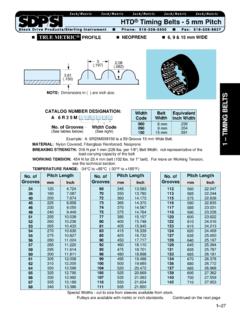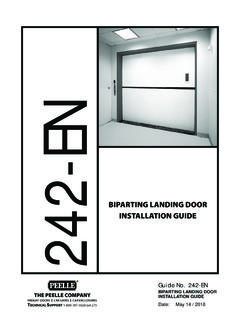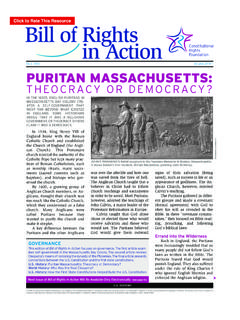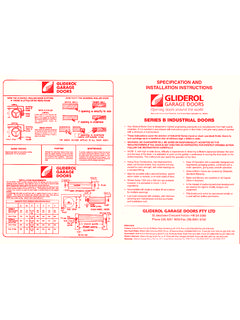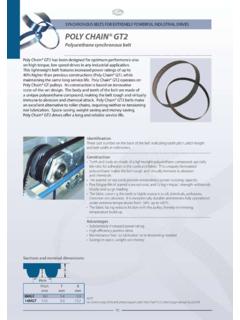Transcription of 3 4 5 6 7 8 9 10 11 12 13 14 15 - SDP/SI
1 PHONE: FAX: IR12345678910111213T1415 ATIMING BELTS, PULLEYS, CHAINS AND SPROCKETS Handbook of Timing Belts, Pulleys, Chains and Sprockets The Technical Section of this catalog is the result of close cooperation of Stock Drive Products / Sterling Instrument staff with experts in the fields of power transmission design and manufacturing. We wish, therefore, to recognize the contribution of the following company and individuals: The Gates Rubber Company, that provided the material contained in their publication 17183. Staff of Stock Drive Products / Sterling Instrument. No part of this publication may be reproduced in any form or by any means without the prior written permission of the Company.
2 This does not cover material which was attributed to another : FAX: TIMING BELTS, PULLEYS, CHAINS AND SPROCKETSTABLE OF CONTENTS PAGESECTION 1 INTRODUCTION ..T-3 SECTION 2 GATES POWERGRIP GT 3 BELT DRIVES ..T-4 SECTION 3 COMPARISON GRAPHS ..T-6 SECTION 4 DRIVE COMPARATIVE STUDIES ..T-8 Durability ..T-8 Tooth Jump Resistance ..T-8 Noise ..T-9 Positioning Accuracy ..T-9 SECTION 5 DIFFERENT BELT CONFIGURATIONS ..T-10 Double-Sided Twin Power Belt Drives ..T-10 Long Length Timing Belt Stock ..T-10 SECTION 6 BELT CONSTRUCTION.
3 T-10 Characteristics Of Reinforcing Fibers ..T-11 Cord Twist And Its Effect On The Drive ..T-12 Factors Contributing To Side Travel ..T-13 Characteristics Of Belt Body Materials ..T-14 SECTION 7 BELT TOOTH PROFILES ..T-15 SECTION 8 PULLEY PITCH AND OUTSIDE DIAMETERS ..T-16 SECTION 9 DESIGN AND INSTALLATION SUGGESTIONS ..T-22 Low-Speed Operation ..T-23 High-Speed Operation ..T-23 Smooth Running ..T-24 Drive Noise ..T-24 Static Conductivity ..T-24 Operating Environments ..T-25 Belt Tracking ..T-26 Pulley Flanging ..T-27 Registration ..T-28 SECTION 10 BELT TENSIONING.
4 T-29 What Is Proper Installation Tension ..T-29 Making Measurements ..T-31 SECTION 11 DRIVE ALIGNMENT ..T-32 Angular And Parallel ..T-32 Practical Tips ..T-33 SECTION 12 INSTALLATION AND TAKE-UP ..T-33 Installation Allowance ..T-33T-1 PHONE: FAX: IR12345678910111213T1415 ATIMING BELTS, PULLEYS, CHAINS AND SPROCKETS Belt Installation ..T-33 Belt Take-up ..T-34 Fixed Center Drives ..T-34 SECTION 13 IDLER USAGE ..T-35 Inside/Outside ..T-35 Tight Side/Slack Side ..T-35 Idler Placement ..T-35 Spring-Loaded Idlers ..T-35 Size Recommendations.
5 T-35 Specifying Shaft Locations In Multipoint Drive Layouts ..T-36 SECTION 14 BELT PULL AND BEARING LOADS ..T-37 Motion Transfer Drives ..T-38 Power Transmission Drives ..T-38 Registration Drives ..T-39 Bearing Load Calculations ..T-39 SECTION 15 HANDLING AND STORAGE ..T-40 SECTION 16 STANDARDS APPLICABLE TO BELTS ..T-40 SECTION 17 STANDARDS APPLICABLE TO PULLEYS AND FLANGES ..T-42 Pulley Tolerances ..T-43 Pulley Materials ..T-46 Flange Design And Face Width Guidelines ..T-46 Guidelines For PowerGrip GT 3 Flange Design ..T-47 SECTION 18 DOUBLE-SIDED TWIN POWER BELT TOLERANCES.
6 T-48 SECTION 19 LONG LENGTH TIMING BELT STOCK SPECIFICATIONS ..T-49 SECTION 20 DESIGN AIDS ON INTERNET ( ) ..T-50 SECTION 21 DRIVE RATIO TABLES ..T-51 SECTION 22 CENTER DISTANCE FORMULAS ..T-58 Nomenclature And Basic Equations ..T-58 Exact Center Distance Determination Unequal Pulleys ..T-58 Exact Center Distance Determination Equal Pulleys ..T-59 Approximate Center Distance Determination ..T-59 Number Of Teeth In Mesh (TIM) ..T-59 Determination Of Belt Size For Given Pulleys And Center Distance ..T-60 SECTION 23 CENTER DISTANCE FACTOR TABLES ..T-60 SECTION 24 TIMING BELT DRIVE SELECTION PROCEDURE.
7 T-61 LIST OF TABLES ..T-83 LIST OF FIGURES ..T-85T-2IR12345678910111213T1415 APHONE: FAX: TIMING BELTS, PULLEYS, CHAINS AND SPROCKETSSECTION 1 INTRODUCTION Timing belts are parts of synchronous drives which represent an important category of drives. Characteristically, these drives employ the positive engagement of two sets of meshing teeth. Hence, they do not slip and there is no relative motion between the two elements in mesh. Due to this feature, different parts of the drive will maintain a constant speed ratio or even a permanent relative position. This is extremely important in applications such as automatic machinery in which a definite motion sequence and/or indexing is involved.
8 The positive nature of these drives makes them capable of transmitting large torques and withstanding large accelerations. Belt drives are particularly useful in applications where layout flexibility is important. They enable the designer to place components in more advantageous locations at larger distances without paying a price penalty. Motors, which are usually the largest heat source, can be placed away from the rest of the mechanism. Achieving this with a gear train would represent an expensive solution. Timing belts are basically flat belts with a series of evenly spaced teeth on the inside circumference, thereby combining the advantages of the flat belt with the positive grip features of chains and gears.
9 There is no slippage or creep as with plain flat belts. Required belt tension is low, therefore producing very small bearing loads. Synchronous belts will not stretch and do not require lubrication. Speed is transmitted uniformly because there is no chordal rise and fall of the pitch line as in the case of roller chains. The tooth profile of most commonly known synchronous belts is of trapezoidal shape with sides being straight lines which generate an involute, similar to that of a spur gear tooth. As a result, the profile of the pulley teeth is involute. Unlike the spur gear, however, the outside diameter of a timing pulley is smaller than its pitch diameter, thus creating an imaginary pitch diameter which is larger than the pulley itself.
10 This is illustrated in Figure 1. Backlash between pulley and belt teeth is negligible. The trapezoidal shape timing belt was superseded by a curvilinear tooth profile which exhibited some desirable and superior qualities. Advantages of this type of drive are as follows: Proportionally deeper tooth; hence tooth jumping or loss of relative position is less probable. Lighter construction, with correspondingly smaller centrifugal loss. Smaller unit pressure on the tooth since area of contact is larger. Greater shear strength due to larger tooth cross section. Lower cost since a narrower belt will handle larger load.


